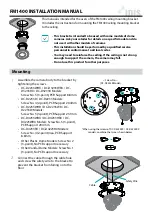
P
AGE
3
Section 1 - General
Section 1 - General
Section 1 - General
Section 1 - General
Section 1 - General
1.1 MOUNTING
1.1 MOUNTING
1.1 MOUNTING
1.1 MOUNTING
1.1 MOUNTING
The Model HC1-series electrodeless conductivity sensor measures the conductivity of solutions
from 0-200 up to 0-2,000,000 microSiemens/cm.
The sensor is constructed of 3A approved materials and has a sanitary 2" tri-clamp process
connection. The sensor may be installed in a special 2" x 2" sanitary tee (available from
Anderson), or in a standard 2 1/2" x 2", or 3" x 2" short outlet reducing tee.
1.2 WETTED MATERIALS
1.2 WETTED MATERIALS
1.2 WETTED MATERIALS
1.2 WETTED MATERIALS
1.2 WETTED MATERIALS
The sensor is constructed of
PVDF or
PFA Teflon
depending on option choice
.
1.3 OPERATING PRECAUTIONS
1.3 OPERATING PRECAUTIONS
1.3 OPERATING PRECAUTIONS
1.3 OPERATING PRECAUTIONS
1.3 OPERATING PRECAUTIONS
Always consider the temperature/pressure ratings of the mounting hardware used to install the
sensor. The sensor and hardware combine to become an integrated system. The hardware
material usually limits the system’s temperature/pressure rating. Refer to Section 2 for complete
specifications.
Section 2 - Specifications
Section 2 - Specifications
Section 2 - Specifications
Section 2 - Specifications
Section 2 - Specifications
Wetted Materials
PVDF or
PFA Teflon®
Operating Temperature Range
14 to 3
47
°F (-10 to
175
°C)
Measuring Range
From 0-200 to 0-2,000,000 microSiemens/cm
Temperature Compensator
Pt 1000 RTD
Sensor Cable:
5 conductor (plus two isolated shields) cable with Teflon-
coated jacket; rated to
175
°C (3
47
°F); 20 ft. (6 m) long
Pressure/Temperature Limits:
200 psi at 3
47
°F (13.8 bar at
175
°C)
* Ratings for above sensor are based upon water service. More severe service may require a
correction factor.
Teflon
®
is a registered DuPont Co. Trademark.
Section 3 - Location Requirements
Section 3 - Location Requirements
Section 3 - Location Requirements
Section 3 - Location Requirements
Section 3 - Location Requirements
Locate the sensor as close as possible to the instrument. Depending on the instrument model
and full-scale range, the maximum allowable distance between sensor and instrument varies
(refer to instrument manual for distances).
NOTE: When indirectly wiring the sensor to the instrument with interconnect cable and a
junction box, use only an Anderson specified cable. When using a different cable, it
must have equivalent construction: five conductors and two separate isolated shields
— one shielding the signal, and one shielding the overall cable. These specific cable
characteristics protect the measurement signal from electromagnetic interference.
Using a cable with different construction may interfere with the measuring system’s
performance.





























